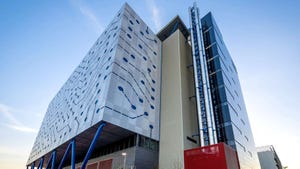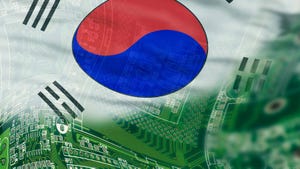
Insight and analysis on the data center space from industry thought leaders.
Powering AI: Navigating the Surge in Energy Demand and Grid ChallengesPowering AI: Navigating the Surge in Energy Demand and Grid Challenges
The AI-driven surge in data center power demand will reshape our thinking about energy consumption, writes Nate Walkingshaw.
September 4, 2024

A lot is going on in the AI hype world, especially when it comes to scaling. Importantly, the AI-driven surge in data center power demand is not just a trend – it's a seismic shift that will reshape our thinking about energy consumption.
AI processing requires an immense amount of energy. To put it in perspective, OpenAI’s ChatGPT alone consumes around 1 GWh a day – enough electricity to power 33,000 homes - and that is just one AI model. This is just an atom-sized use case compared to the demand driven by data centers.
By 2028, the data center concurrent peak load is expected to climb from 808 MW in 2023 to 4.6 GW – enough to power 3.8 million homes – and AI is predicted to represent nearly 20% of data center demand.
The grid is under immense strain, requiring urgent upgrades to accommodate the escalating demands and prevent potential blackouts.
The stakes are high: Today’s mission-critical data centers rely on power availability to ensure day-to-day operations are uninterrupted and data is continuously secure and available. Even a brief power outage can cost data centers and their clients thousands of dollars per minute of downtime.
Sustainable solutions are no longer optional; they’re critical to meeting the needs of this rapidly evolving technology landscape.
When presenting about AI’s energy consumption at the World Economic Summit, OpenAI CEO Sam Altman said: “We won’t get there without a breakthrough.” Now is the time to work together to make renewable options viable for delivering electricity where it's needed.
Where Will the Power Come From?
With a clear need for long-term and reliable solutions, energy planners at major utilities are now having to rethink their power plans to accommodate the rapid growth of AI-driven power demand from data centers.
For example, an August 2024 forecast from the Northwest Power and Conservation Council projects that by 2029, data centers could consume an average of around 4 GW of electricity. This is more electricity annually than Puget Sound Energy, which serves over 1.2 million residential, commercial, and industrial customers in the Pacific Northwest.
This surge in demand is pushing the region to the brink of a power shortfall, significantly increasing the risk of widespread blackouts.
Although the Northwestern US has incorporated solar and wind power into its energy mix, these sources are intermittent and heavily reliant on weather conditions, failing to meet the growing demands.
The NPCC emphasized in its report that increasing the capacity of renewable energy could be the key to reducing this demand growth to about 3% per year, reaching approximately 1.4 average GW by 2029.
Storage and backup supply also remain challenges. Historically, many data centers have relied on diesel generators as backup. However, reliance on diesel comes with significant environmental and public health costs, supply chain vulnerabilities, and depletion risk, leading to price volatility.
These challenges underscore the urgent need for more reliable and scalable energy solutions to prevent a potential crisis.
What Is Happening to the Grid?
Imagine the grid as a network of pipes carrying electricity from power plants to where it's needed. When data centers demand vast amounts of energy, it’s like trying to push a massive volume of water through pipes that can only handle so much flow.
This creates congestion, where transmission lines – already operating at capacity – struggle to carry the extra load.
Just as water pipes burst under pressure, these congested lines can overheat, risking damage and outages. To prevent this, grid operators must reroute electricity through less crowded lines, but this slows down the overall flow, making it harder to deliver power efficiently.
How Can Distributed Energy Storage Help?
Distributed energy storage systems are crucial in meeting growing data center power demand and safeguarding the grid. While expanding and upgrading transmission lines can help alleviate grid congestion, these projects are costly and take decades to complete.
In contrast, new and renewable technologies like Flywheel Energy Storage Systems (FESS) and Battery Energy Storage Systems (BESS) offer more immediate and flexible options. Distributed FESS and BESS systems can typically be deployed within six months, and can easily scale to meet increasing demand with the addition of more storage units.
FESS operates like a high-speed spinning wheel that can store excess energy in milliseconds and release it back into the grid when demand fluctuates. This rapid response helps smooth out the flow of electricity, much like a water tank stores extra water during a heavy rainstorm to release it later when it is most needed.
BESS, on the other hand, acts as a giant rechargeable battery, storing energy during periods of low demand and releasing it when the grid is strained. This balances the flow of electricity and prevents congestion, similar to how a reservoir holds and releases water to control the flow in a river.
Companies like Microsoft prove the efficacy of these systems: The technology leader is piloting a large-scale BESS in its Swedish data center to replace diesel generators – a major step towards its goal of becoming carbon-negative by 2030. According to the manufacturer, the BESS provides 16MWh of storage, equating to 80 minutes of backup energy, and can provide peak power of 24 MW.
FESS and BESS can also work together, acting like big storage tanks for electricity, to address the challenges of grid congestion and stability, mitigating the energy challenges posed by data centers. FESS offers a fast response, instantly absorbing sudden surges in energy demand, while BESS provides longer-term storage by capturing excess energy during low demand and releasing it when the grid is under pressure, such as during peak data center operations.
By leveraging these systems, we can make more efficient use of existing infrastructure, reducing the need for costly and time-consuming upgrades to transmission lines.
This collaboration not only ensures a reliable and flexible backup for the grid but also enhances sustainability by storing and managing renewable energy, reducing reliance on fossil fuels.
Together, FESS and BESS act as vital components of a smarter, more resilient power grid, helping to keep electricity flowing smoothly and efficiently and supporting the increasing energy demands of modern data centers.
AI’s Role in Managing Energy
AI plays a dual role as a major energy consumer and as a pivotal enabler of grid decentralization and optimization. Even with BESS and FESS systems, energy management serves as a critical traffic control system for electricity.
Rather than viewing AI as a threat to sustainability, we should harness its capabilities to enhance the efficiency and reliability of our energy infrastructure. By leveraging AI technologies, we can monitor energy usage in real-time, predict future demand with greater accuracy, and make decisions about where to send the energy, implementing data-driven strategies to optimize grid performance.
AI optimizes electrical grids in several ways. It can continuously monitor the grid, especially vulnerable lines, and can automatically redirect power distribution to prevent outages. In the event of damage, AI can quickly assess the impact and guide management in restoring normal operations.
Additionally, AI improves demand forecasting by analyzing historical data, including weather patterns, economic activity, and energy consumption trends. It reduces the computational intensity of power system modeling, making it easier to manage complex grid operations.
AI also enables real-time pricing, optimizing the operation and economics of distributed energy resources and storage, and anticipates system anomalies to avoid disruptions. By integrating these AI-driven solutions, we can build a more sustainable, efficient, and reliable energy infrastructure for the future.
Transitioning to a ‘Shared Energy’ Economy
The relentless growth in AI-driven energy consumption is not just a technological challenge but an environmental and economic one. Transitioning the data center-grid relationship to a collaborative "shared energy economy" could not only help utilities manage AI's rapid growth but also enhance affordability and reliability for all electricity users.
As we stand at the intersection of AI innovation and energy management, it is clear that the road ahead is both challenging and full of opportunity. The surge in AI-driven power demand is reshaping our approach to energy, compelling us to rethink how we generate, store, and distribute electricity.
By embracing sustainable solutions like FESS and BESS, and harnessing the power of AI to optimize grid performance, we can ensure a future where technology and energy work in harmony. It's not just about keeping the lights on – it's about powering the next wave of technological advancement responsibly and efficiently.
Together, we can navigate this new energy landscape, turning challenges into opportunities and building a more resilient, sustainable future for all.
Nate Walkingshaw is the founder and CEO of Torus, an energy solutions company bringing advanced commercial batteries and innovative energy storage technologies like flywheels to enhance grid stability. Nate built Torus just as the AI growth curve was about to spike and now AI is creating massive tailwinds for decentralization of the grid. Nate is dedicated to transforming the way the world interacts with energy.
About the Author
You May Also Like









